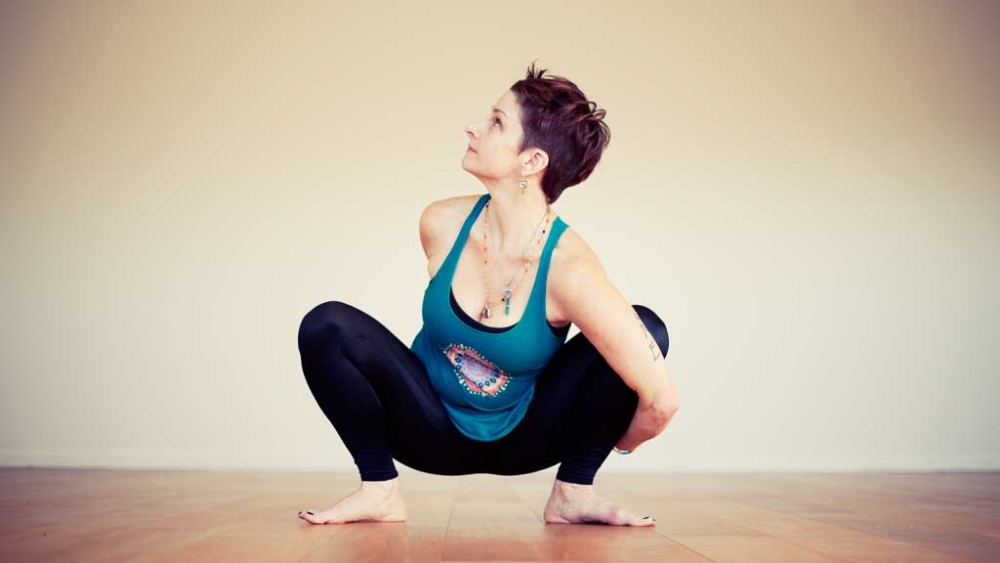The Bandhas are energetic locks which from a physical, Western point of view can simply be taught as:
The activation and engagement of muscle fibers, in strategic areas in the body, that support in the toning and lifting of the systems of the body against the natural laws of gravity.
However, looking at the human body through the more subtle yogic point of view, Bandhas are much more than muscles activating. They can be seen as locks or valves in specific areas of the body that once engaged can control (retain) dissipating pranic energy. Mastering the use of these Bandhas helps in the process of drawing up of Shakti Kundalini energy into the body, specifically up into the Sushumna Nadi, the central channel that correlates with the central nervous system housed in the spinal column.
Mula Bandha – Root Lock
Mula Bandha is one of three major Bandhas, along with Uddiyana Bandha (upward lifting of the diaphragm) and Jalandhara Bandha (chin or throat lock). Maha Bandha is the application of all three of these Bandhas at the same time.
Even an old person becomes young by constantly practicing Mula Bandha” – Hatha Yoga Pradipika.
Physical qualities of Mula Bandha
Mula Bandha is your “Root Lock”. Physiologically, this Bandha is a diamond shape hammock of muscles that spans the space between the bones of the pubis in the front, the two ischium (sitting bones) on the sides and the coccyx in the back. These are your coccygeus, iliococcygeus, and the pubococcygeus muscles – known together as your Levator Ani muscle and form part of the pelvic floor.
Activating and engaging these pelvic floor muscles supports the internal organs of the lower abdominal cavity and brings much needed awareness to the space between the pubis and the coccyx. This connection between front body and back body is usually saved for the overworked psoas muscle, which due to habitual patterns of hip flexion in what we do for work and play is one of the major causes of lower back pain.
Continuous awareness of the space between the pubis and coccyx (and if you can between the sitting bones themselves) in yoga poses and transitions can help alleviate already existing tightness, tension and/or lower back pain and can counteract any future possibility of lower back injury – both on and off the mat.
Practising Mula Bandha – the Subtle (lift) vs Gross (clench) action
It is important to remember that activation of these muscles is not a gross, largely physical movement but more of a subtle one. In both the Hatha and Pranayama portions of our yoga practice, in order to redirect healing pranic energy into a specific area of the body via the Bandhas, it is most beneficial to not tighten or clench. When discussing with my anatomy students how to teach a student the subtle sensations of Mula Bandha I talk about three parts:
- Practise Ashwini Mudra, the contraction of the anal sphincter, as if stopping your poop.
- Practise Vajroli Mudra, the contraction of the urethra, as if stopping the stream of your pee.
- Lastly practise Mula Bandha, a gentle upward tug in your perineum (the space between the genitals and the anus). Imagine a sensation in that space as if a tissue is being drawn up through the cellophane of a tissue box.
Mula Bandha, Shakti Kundalini and the Chakras
Energetically, bringing our awareness to Mula Bandha brings awareness to the dormant energy of Shakti Kundalini at the base of the Sushumna Nadi. By continuously working with and activating Mula Bandha we can begin the slow process of awakening Shakti Kundalini, allowing this feminine creative force to rise up through the lower chakras, healing specific areas of our psycho-spiritual development.
The three chakras most affected are:
Muladhara (root chakra), keywords: survival, safety, trust
Svadisthana (sacral chakra), keywords: sensuality, sexuality, creativity
Manipura (solar plexus chakra), keywords: self-worth, power, will
Some suggested classes for practising Mula Bandha
(for EkhartYoga members)
To really understand the Bandhas, of course, it is essential to practise them and experience their effects. This can take some time and so if you are new to this practice be patient. The following classes focus specifically on Mula Bandha:
- Core support and Mula Bandha
Andrew Wrenn, Level 2, 30 mins, Hatha yoga - Mula Bandha and Uddiyana Bandha clinic
Clayton Horton, All levels, 10 mins, Ashtanga yoga - Mula Bandha: a tutorial for women
Francesca Giusti, All levels, 10 mins, Hatha yoga

